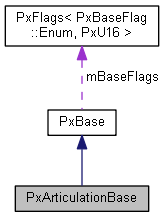a tree structure of bodies connected by joints that is treated as a unit by the dynamics solver
More...
|
| virtual PxScene * | getScene () const =0 |
| | Retrieves the scene which this articulation belongs to. More...
|
| |
| virtual void | setSolverIterationCounts (PxU32 minPositionIters, PxU32 minVelocityIters=1)=0 |
| | Sets the solver iteration counts for the articulation. More...
|
| |
| virtual void | getSolverIterationCounts (PxU32 &minPositionIters, PxU32 &minVelocityIters) const =0 |
| | Retrieves the solver iteration counts. More...
|
| |
| virtual bool | isSleeping () const =0 |
| | Returns true if this articulation is sleeping. More...
|
| |
| virtual void | setSleepThreshold (PxReal threshold)=0 |
| | Sets the mass-normalized energy threshold below which an articulation may go to sleep. More...
|
| |
| virtual PxReal | getSleepThreshold () const =0 |
| | Returns the mass-normalized energy below which an articulation may go to sleep. More...
|
| |
| virtual void | setStabilizationThreshold (PxReal threshold)=0 |
| | Sets the mass-normalized kinetic energy threshold below which an articulation may participate in stabilization. More...
|
| |
| virtual PxReal | getStabilizationThreshold () const =0 |
| | Returns the mass-normalized kinetic energy below which an articulation may participate in stabilization. More...
|
| |
| virtual void | setWakeCounter (PxReal wakeCounterValue)=0 |
| | Sets the wake counter for the articulation. More...
|
| |
| virtual PxReal | getWakeCounter () const =0 |
| | Returns the wake counter of the articulation. More...
|
| |
| virtual void | wakeUp ()=0 |
| | Wakes up the articulation if it is sleeping. More...
|
| |
| virtual void | putToSleep ()=0 |
| | Forces the articulation to sleep. More...
|
| |
| virtual PxArticulationLink * | createLink (PxArticulationLink *parent, const PxTransform &pose)=0 |
| | adds a link to the articulation with default attribute values. More...
|
| |
| virtual PxU32 | getNbLinks () const =0 |
| | returns the number of links in the articulation More...
|
| |
| virtual PxU32 | getLinks (PxArticulationLink **userBuffer, PxU32 bufferSize, PxU32 startIndex=0) const =0 |
| | returns the set of links in the articulation More...
|
| |
| virtual void | setName (const char *name)=0 |
| | Sets a name string for the object that can be retrieved with getName(). More...
|
| |
| virtual const char * | getName () const =0 |
| | Retrieves the name string set with setName(). More...
|
| |
| virtual PxBounds3 | getWorldBounds (float inflation=1.01f) const =0 |
| | Retrieves the axis aligned bounding box enclosing the articulation. More...
|
| |
| virtual PxAggregate * | getAggregate () const =0 |
| | Retrieves the aggregate the articulation might be a part of. More...
|
| |
| virtual PxArticulationImpl * | getImpl ()=0 |
| |
| virtual const PxArticulationImpl * | getImpl () const =0 |
| |
| virtual | ~PxArticulationBase () |
| |
| virtual PxArticulationJointBase * | createArticulationJoint (PxArticulationLink &parent, const PxTransform &parentFrame, PxArticulationLink &child, const PxTransform &childFrame)=0 |
| |
| virtual void | releaseArticulationJoint (PxArticulationJointBase *joint)=0 |
| |
| virtual void | release ()=0 |
| | Releases the PxBase instance, please check documentation of release in derived class. More...
|
| |
| virtual const char * | getConcreteTypeName () const =0 |
| | Returns string name of dynamic type. More...
|
| |
| template<class T > |
| T * | is () |
| |
| template<class T > |
| const T * | is () const |
| |
| PX_FORCE_INLINE PxType | getConcreteType () const |
| | Returns concrete type of object. More...
|
| |
| PX_FORCE_INLINE void | setBaseFlag (PxBaseFlag::Enum flag, bool value) |
| | Set PxBaseFlag. More...
|
| |
| PX_FORCE_INLINE void | setBaseFlags (PxBaseFlags inFlags) |
| | Set PxBaseFlags. More...
|
| |
| PX_FORCE_INLINE PxBaseFlags | getBaseFlags () const |
| | Returns PxBaseFlags. More...
|
| |
| virtual bool | isReleasable () const |
| | Whether the object is subordinate. More...
|
| |
a tree structure of bodies connected by joints that is treated as a unit by the dynamics solver
Articulations are more expensive to simulate than the equivalent collection of PxRigidDynamic and PxJoint structures, but because the dynamics solver treats each articulation as a single object, they are much less prone to separation and have better support for actuation. An articulation may have at most 64 links.
- See also
- PxArticulationJoint PxArticulationLink PxPhysics.createArticulation
| virtual bool PxArticulationBase::isSleeping |
( |
| ) |
const |
|
pure virtual |
Returns true if this articulation is sleeping.
When an actor does not move for a period of time, it is no longer simulated in order to save time. This state is called sleeping. However, because the object automatically wakes up when it is either touched by an awake object, or a sleep-affecting property is changed by the user, the entire sleep mechanism should be transparent to the user.
An articulation can only go to sleep if all links are ready for sleeping. An articulation is guaranteed to be awake if at least one of the following holds:
- The wake counter is positive (see setWakeCounter()).
- The linear or angular velocity of any link is non-zero.
- A non-zero force or torque has been applied to the articulation or any of its links.
If an articulation is sleeping, the following state is guaranteed:
- The wake counter is zero.
- The linear and angular velocity of all links is zero.
- There is no force update pending.
When an articulation gets inserted into a scene, it will be considered asleep if all the points above hold, else it will be treated as awake.
If an articulation is asleep after the call to PxScene::fetchResults() returns, it is guaranteed that the poses of the links were not changed. You can use this information to avoid updating the transforms of associated of dependent objects.
- Note
- It is invalid to use this method if the articulation has not been added to a scene already.
- Returns
- True if the articulation is sleeping.
- See also
- isSleeping() wakeUp() putToSleep() getSleepThreshold()
| virtual void PxArticulationBase::setSolverIterationCounts |
( |
PxU32 |
minPositionIters, |
|
|
PxU32 |
minVelocityIters = 1 |
|
) |
| |
|
pure virtual |
Sets the solver iteration counts for the articulation.
The solver iteration count determines how accurately joints and contacts are resolved. If you are having trouble with jointed bodies oscillating and behaving erratically, then setting a higher position iteration count may improve their stability.
If intersecting bodies are being depenetrated too violently, increase the number of velocity iterations. More velocity iterations will drive the relative exit velocity of the intersecting objects closer to the correct value given the restitution.
- Parameters
-
| [in] | minPositionIters | Number of position iterations the solver should perform for this articulation. Range: [1,255] |
| [in] | minVelocityIters | Number of velocity iterations the solver should perform for this articulation. Range: [1,255] |
- See also
- getSolverIterationCounts()




 Public Member Functions inherited from PxBase
Public Member Functions inherited from PxBase Protected Member Functions inherited from PxBase
Protected Member Functions inherited from PxBase Protected Attributes inherited from PxBase
Protected Attributes inherited from PxBase